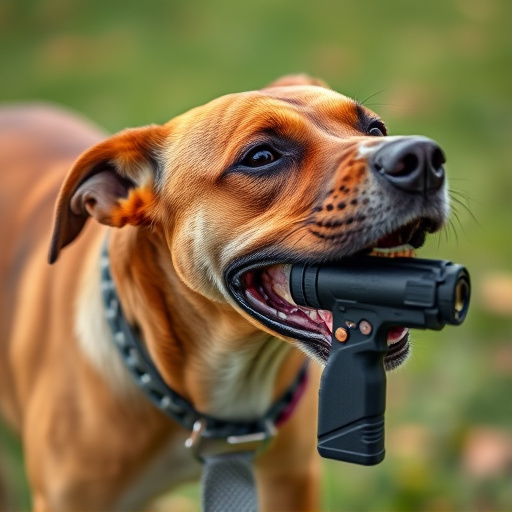Dog aggression, untamed, poses risks. When conventional training methods fail, Proper Mace Spray Dog Training Techniques offer a last resort. These techniques emphasize responsible usage, safety, and controlled deployment for de-escalation. Choosing the right dog attack spray with quick-release mechanisms is key. Legal considerations and comprehensive training are crucial before employing pepper spray as a safety measure against dog attacks.
In the realm of dog training, understanding aggression and knowing when to deploy deterrents like dog attack spray is crucial. This article delves into essential aspects of proper mace spray dog training techniques, focusing on handling, release mechanisms, and safety precautions. We explore ‘when to use’ scenarios, guiding owners through effective deployment for both training and protection. By embracing these strategies, folks can foster a safer, more harmonious environment with their four-legged companions.
- Understanding Dog Aggression and When to Use Spray
- Choosing the Right Mace Spray for Dog Training
- Demonstrating Proper Handling Techniques
- Effective Release Mechanisms: Quick vs. Controlled
- Safety Precautions and Training Tips for Owners
Understanding Dog Aggression and When to Use Spray
Dog aggression can stem from a variety of factors, including fear, territorial behavior, or even excitement. Understanding when a dog might display aggressive tendencies is crucial for pet owners and walkers. Proper mace spray dog training techniques should be considered as a last resort when other methods like positive reinforcement and desensitization have failed.
Knowing when to use spray is equally important. If a dog approaches in an agitated or menacing manner, and its owner is unable to control the situation, a quick-release spray can provide a safe buffer. The key lies in ensuring it’s used responsibly and ethically, always aiming for de-escalation rather than harm.
Choosing the Right Mace Spray for Dog Training
When considering a mace spray for dog training, it’s crucial to select one designed specifically for animal control and training purposes. Look for products marketed as “proper mace spray for dog training” or “dog training techniques spray,” which are typically less potent than self-defense mace and formulated with ingredients safe for animals. These specialized sprays often have a shorter range and quicker dissipation rate, ensuring they’re effective without causing excessive harm.
The right spray should be easy to deploy in split seconds, featuring a quick-release mechanism that allows trainers to protect both themselves and the dog from unexpected aggression. Training with such a tool demands consistency, practice, and clear communication. Always follow safety guidelines, wear protective gear if necessary, and ensure the dog is familiarized with the scent and sensation of the spray before using it in training scenarios.
Demonstrating Proper Handling Techniques
Learning and demonstrating proper handling techniques for mace spray during dog attack scenarios is paramount. It starts with thorough training that covers not just how to deploy the spray, but also understanding the timing and distance required for optimal effectiveness. The training should include role-playing different attack situations, teaching individuals to remain calm and assess the situation swiftly. Practicing proper grip and finger placement on the spray canister ensures a quick release when needed.
Rehearsing these techniques regularly enhances muscle memory, allowing for instinctive responses during high-stress events. It’s also crucial to discuss and incorporate safety measures to prevent accidental discharge and mistaking the spray for other tools. Regular reviews and updates of training protocols keep everyone prepared, ensuring that proper mace spray dog training techniques are not just theoretical but practical and life-saving skills.
Effective Release Mechanisms: Quick vs. Controlled
When it comes to dog attack spray, the release mechanism is a critical component that impacts its effectiveness. Traditional mace sprays often utilize a controlled release system, where the user has to pull a trigger or lever to dispense the spray. While this method offers precise control, allowing for targeted use and minimizing waste, it may not always be suitable in high-stress situations.
In contrast, quick release mechanisms have gained popularity due to their ease of use. These designs enable immediate deployment with just a simple press of a button or flip of a switch. This rapid response can be invaluable during unanticipated dog encounters. However, proper mace spray dog training techniques are essential to ensure users deploy the spray safely and effectively, especially in close-quarters or chaotic scenarios.
Safety Precautions and Training Tips for Owners
When it comes to dog attack spray, safety precautions are paramount. Owners must familiarize themselves with local laws and regulations regarding the use of pepper spray on dogs. It’s crucial to understand that proper mace spray dog training techniques involve more than just purchasing the device; it requires comprehensive preparation and ongoing practice.
Training tips for owners include teaching their dogs basic commands like “sit,” “stay,” and “come” before introducing the spray. Positive reinforcement methods, such as treats and praise, can help dogs associate the spray with a positive outcome rather than fear or punishment. Regular simulations of potential attack scenarios in a controlled environment allow dogs to become accustomed to the spray’s effects while maintaining their trust in their owner.
When used correctly, dog attack spray with a quick release mechanism can be an effective tool for training and protecting against aggressive behavior. Understanding when and how to deploy it, along with proper handling techniques, ensures safety for both owner and dog. Choosing the right mace spray designed for canine training is key, paired with comprehensive safety precautions and owner education. By mastering these proper Mace spray dog training techniques, owners can enhance their ability to manage and prevent potential attacks, fostering a safer environment for everyone.
